×


We have detected your country as:
Please click here to go to the USA website or select another country from the dropdown list.

{image_1} One of the most beautiful mosaics in Israel, which was discovered 13 years ago in Lod (home to Ben Gurion International Airport) and then covered over, was uncovered a second time and opened to the public for three days in July. The 1,700-year-old mosaic is to be moved to the Israel Antiquities Authority (IAA) laboratories where conservation work will be undertaken for the next two years, after which it will be permanently returned to Lod.
Continue Reading »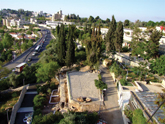
{image_1} Most Jerusalemites identify the Sultan’s Pool as a venue where large cultural events are held [outside the Old City walls down from Jaffa Gate]; however, for hundreds of years, it was one of the city’s most important water reservoirs. In an archaeological excavation the Israel Antiquities Authority (IAA) recently conducted prior to the construction of the Montefiore Museum, an aqueduct—originally built by Herod—was uncovered that conveyed water to the Temple Mount and also served as the principal water supply to the Sultan’s Pool.
Continue Reading »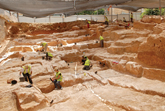
{image_1}
An ancient quarry, c. 1 dunam [0.25 acre] in area and dating to the end of the Second Temple period (c. 2,030 years old), was uncovered in excavations in Jerusalem, under the direction of Dr. Ofer Sion and Yehuda Rapuano of the Israel Antiquities Authority, prior to the construction of residential buildings.

{image_1} History has it that the great rulers of Canaan were all men. An exception may have been unearthed in a dig at Tel Beit-Shemesh [between Jerusalem and Tel Aviv]. Two archaeologists, Professor Shlomo Bunimovitz and Dr. Zvi Lederman of Tel Aviv University (TAU), have uncovered an unusual ceramic plaque of a goddess in male dress. The plaque depicts a figure dressed as a royal male figure or deity found in ancient Egyptian and Canaanite art. However, the figure's hairstyle is womanly and its bent arms are holding lotus flowers—attributes given to women. According to Lederman, an art historian, the figure may be an artistic representation of the “Mistress of the Lionesses”—a female Canaanite ruler who, via clay tablets [first discovered in Egypt in 1887], was known to have sent several distress letters to the Pharaoh in Egypt around 1350 BC.
Continue Reading »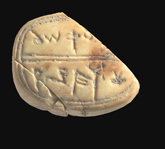
{image_1} Recently, two artifacts with ancient Hebrew lettering from the name First typeTemple period (1006–586 BC) were found in Jerusalem. It is amazing the history that archaeologists can glean from such small artifacts.
Continue Reading »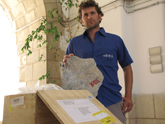
{image_1} A Christian tourist confessed a couple of months ago, via his priest, that he had “stolen” an artifact when he was on tour 12 years ago. Wanting a fragment to remind him to pray for Jerusalem, he had asked if he could purchase one and was told he couldn’t. However, his Israeli tour guide “gave” it to him as a “gift.” Not knowing any better, he kept it until his conscience got the better of him, when he then shipped it back to Israel along with a note of apology and plea for forgiveness. Since it was returned intact, the Israel Antiquities Authority (IAA) did not press charges.
Continue Reading »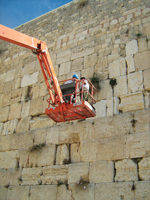
{image_1} The Israel Antiquities Authority (IAA) not only finds buried “treasures” of the past but works to preserve them. A year ago, the Western Wall Heritage Foundation conducted a survey of the state of the wall, which revealed that the physical condition of the stones was deteriorating. IAA decided to take urgent action.
Continue Reading »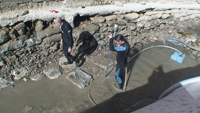
{image_1} The IAA Marine Archaeology Unit is rehabilitating Akko’s [Acre’s] southern seawall. As part of the project, a temporary rampart, which serves as both a road and dam, was built in the sea. The pool of water that formed between the rampart and the seawall was pumped out to create dry conditions for the rehabilitation. Kobi Shavit, director of the project, explained that the project “will eliminate any danger of the seawall collapsing.”
Continue Reading »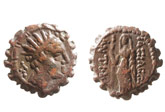
{image_1}
Not far away, and about the same time, two other rare coins were found from the siftings of the Temple Mount rubble across the Kidron Valley on Mount Scopus. For the past four years, over 40,000 volunteers have found a total of 3,500 coins. In December, a 14-year-old volunteer found a silver half-shekel coin used for the biblical Temple tax (Exod. 30:11–15). Minted in AD 66–67 during the Jewish revolt against the Romans, these coins, wherever found, are considered the rarest of finds.
Continue Reading »
{image_1}
If finding gold wasn’t enough, in late January, the City of David excavation team also unearthed Israel’s one-of-a-kind 1,800-year-old Roman marble figurine. Though many others like it have been found throughout various parts of the Roman Empire, this one is a first for Israel. Similar statues in Israel have been made of bronze.
Continue Reading »All logos and trademarks in this site are property of their respective owner. All other materials are property of Bridges for Peace. Copyright © 2024.
Website Site Design by J-Town Internet Services Ltd. - Based in Jerusalem and Serving the World.